China buys Argentine barley after slapping Australia with 80 per cent tariff
Three months after imposing an 80 per cent tariff on Australian barley imports, China has turned to Argentina for supplies of the grain used for livestock feed and beer.

Photo supplied
Argentina is on track to send at least 250,000 tonnes this year and a record 380,000 tonnes in 2021, according to export licences and private company declarations seen by Reuters. That is up from virtually nothing in 2019.
“We loaded a ship on Sunday with 65,000 tonnes headed for China. And we have three or four shipments scheduled for January,” said an Argentina-based trader with an international grains company who asked not to be named.
“China turned toward us this year because of its conflict with Australia,” the trader said, referring to a political spat that saw China slap an 80 per cent tariff on Australian barley imports in May.
The 80.5 per cent tariff includes a dumping margin of 73.6 per cent and a subsidy margin of up to 6.9 per cent on all barley imported from Australia for five years.
The tariffs are in response to investigations initiated by China in November 2018.
Australia’s barley output – estimated at 10.2 million tonnes in the 2020/21 crop year according the US Department of Agriculture – dwarfs Argentina’s 3.5 million tonnes.
South Australia produced a little over 2 million tonnes of barley last season, about a quarter of the national production and is the second largest barley-producing state behind Western Australia.
National peak body GrainGrowers said in May that te tariffs will disrupt and most likely halt exports to China until the situation is resolved. It estimated the dispute could cost Australian grain industry and regional economies at least $500 million a year.
Eugenia Rul, head analyst at the Bahia Blanca Grains Exchange, said that prior to the Sunday shipment Argentina had sent 160,000 tonnes of barley to China in the last two months.
Argentine feed barley is shipped to Saudi Arabia, where it is used to feed camels, while its beer barley has gone mostly to South American brewers. Australia was China’s main supplier.
“It’s clear that China is choosing Argentina, very aggressively, as a new provider of barley,” said Agustin Baque, a farm consultant and commodities trader specialising in barley, based in the Atlantic port city of Necochea.
Baque said the China-Australia conflict was pushing up demand for both beer and feed barley. “For 2021 we have business confirmed for 380,000 tonnes of Argentine barley to be exported to China, 180,000 of which will be malting barley,” he said.
He said Argentine barley exports to China next year could reach as much as 800,000 tonnes depending on prices and the Australia-China trade relationship.
China is the top global importer of malt barley for brewing beer. It also uses the grain to feed livestock.
“We are going to play (in) Australia’s market basically because Australia is now looking to sell it’s barley someplace other than China,” said Robbie Cameron, a grower in the southern Buenos Aires agricultural area of Loberia.
“Australia is going to compete for our usual feed barley market, which is Saudi Arabia, and our malting barley markets in South America, so we are going to have to look at different places as well, like China,” he added.
With the best soils of the Pampas spread over an area larger than the size of France, Argentine growers said that if the China-Australia trade spat stretches into 2021, there will be plenty of room to plant more barley to meet increased demand.
Australia’s barley output – estimated at 10.2 million tonnes in the 2020/21 crop year according the US Department of Agriculture – dwarfs Argentina’s 3.5 million tonnes.
-with AAP
Want to comment?
Send us an email, making it clear which story you’re commenting on and including your full name (required for publication) and phone number (only for verification purposes). Please put “Reader views” in the subject.
We’ll publish the best comments in a regular “Reader Views” post. Your comments can be brief, or we can accept up to 350 words, or thereabouts.




